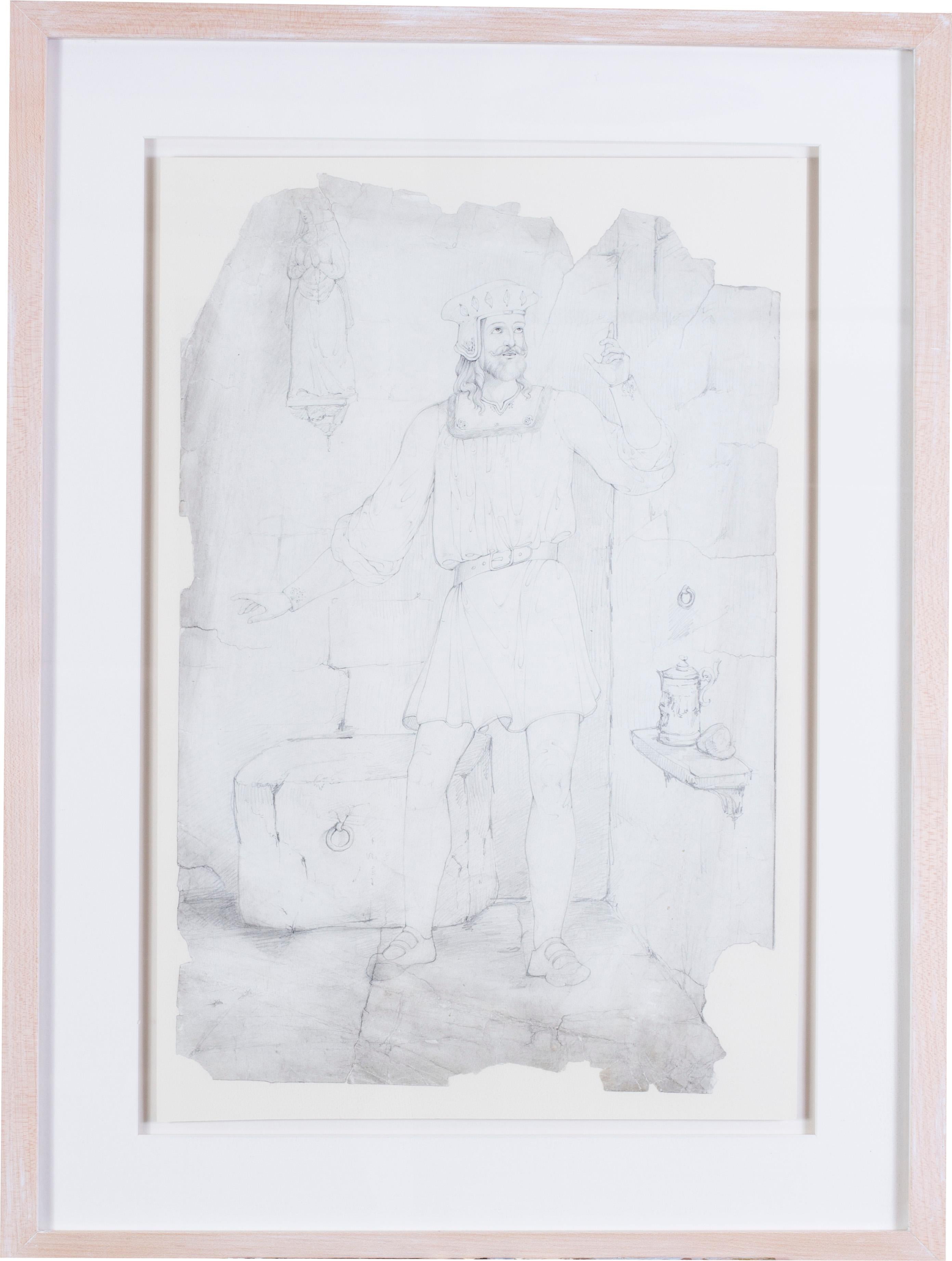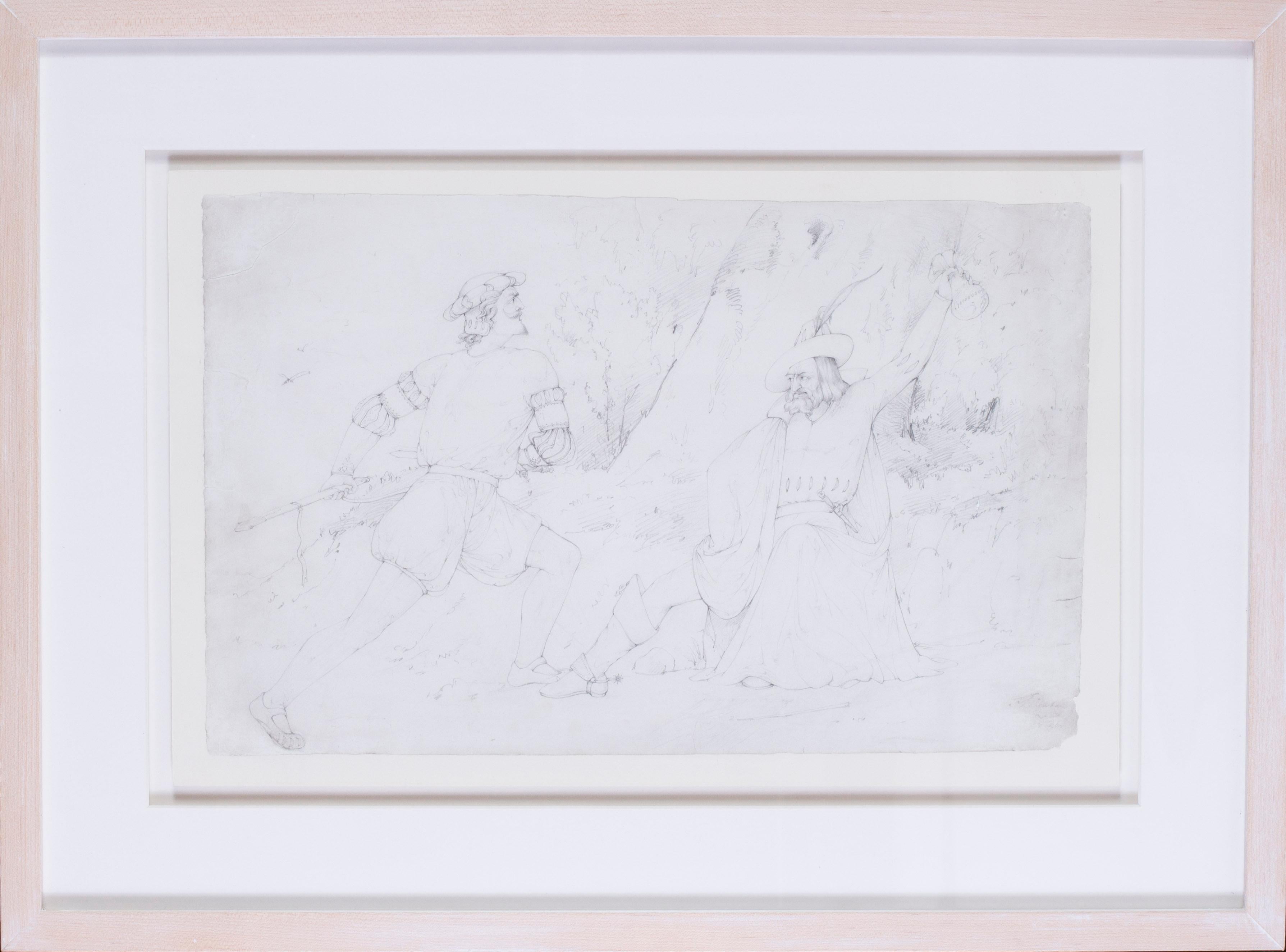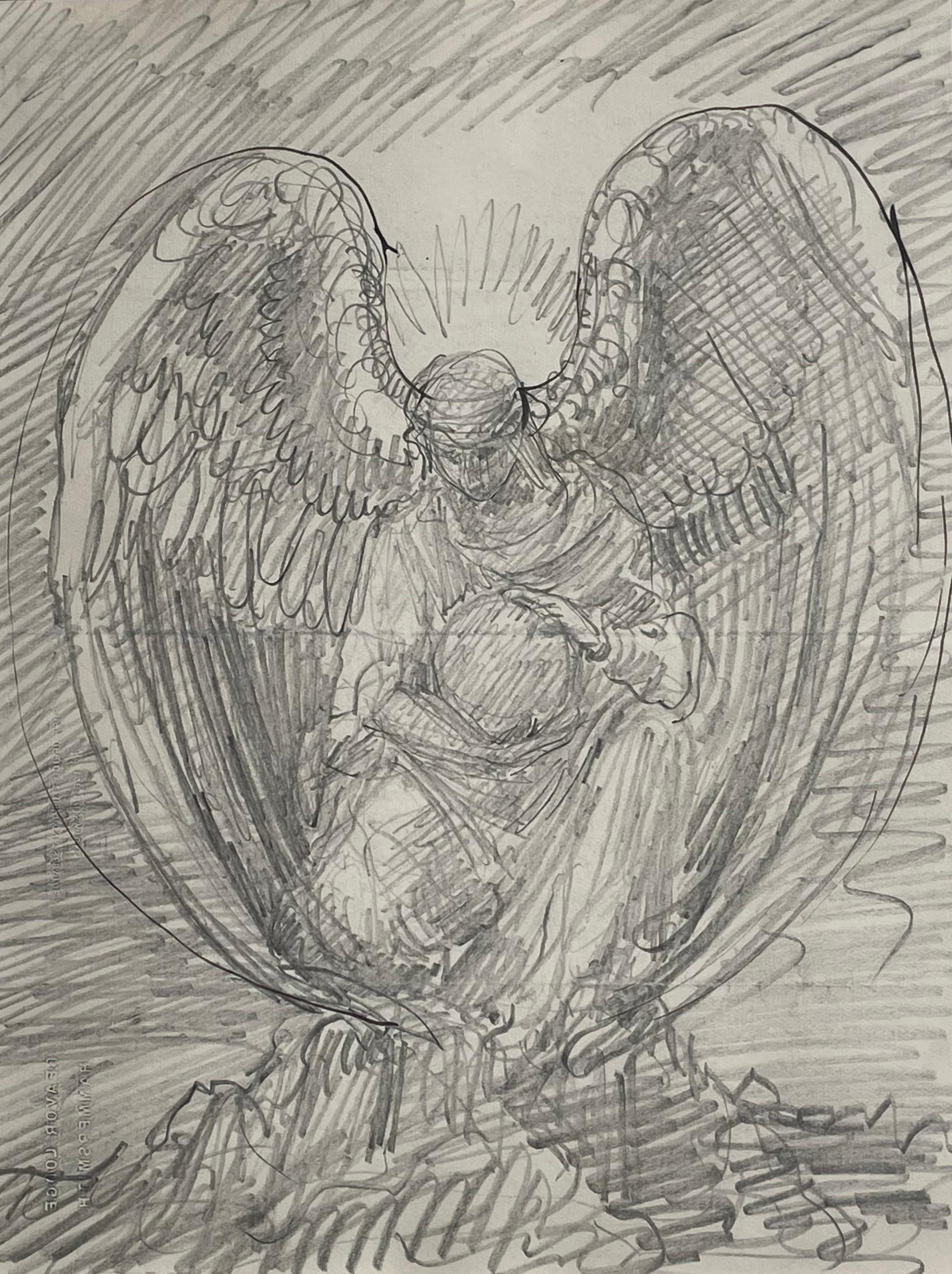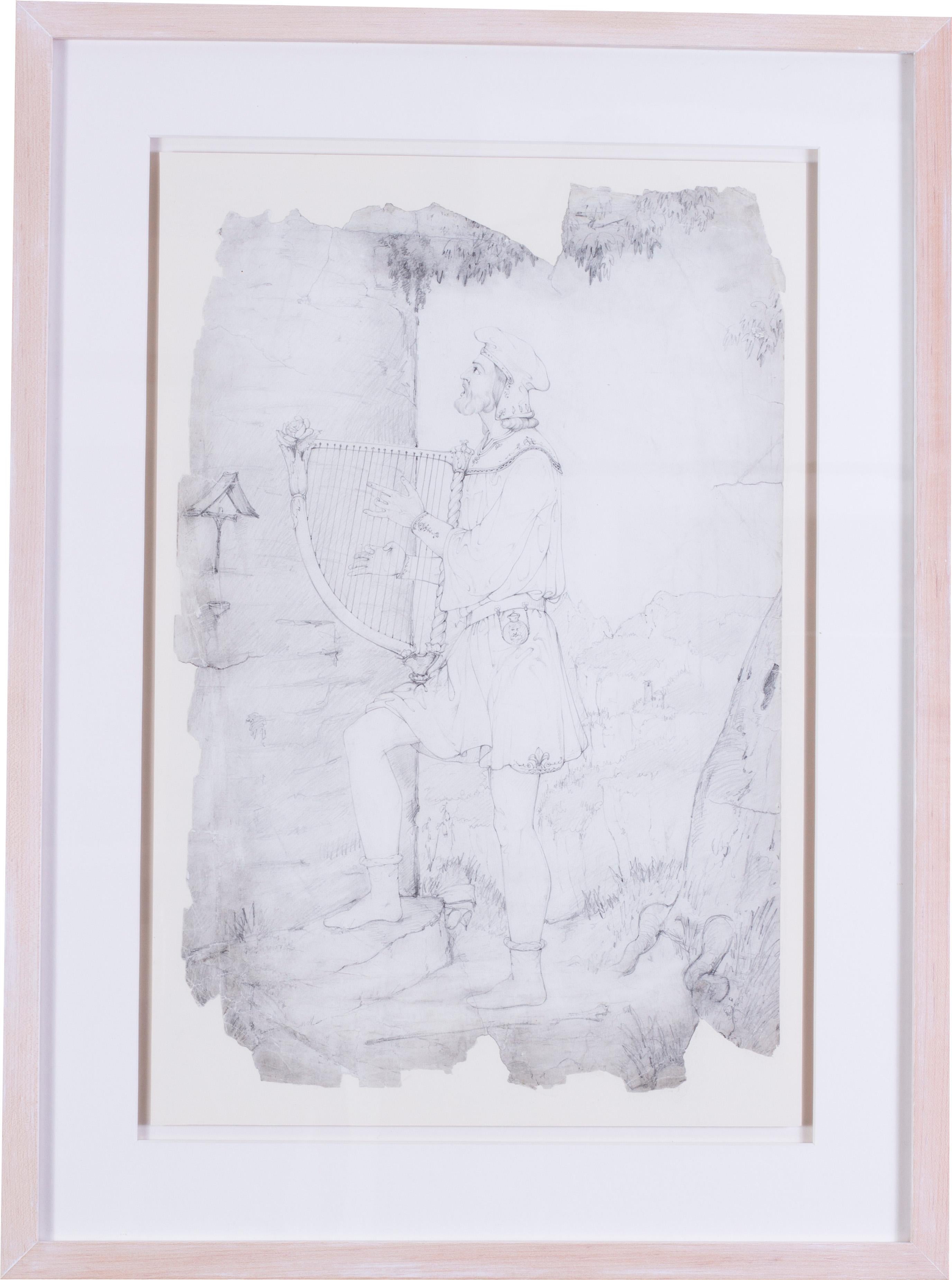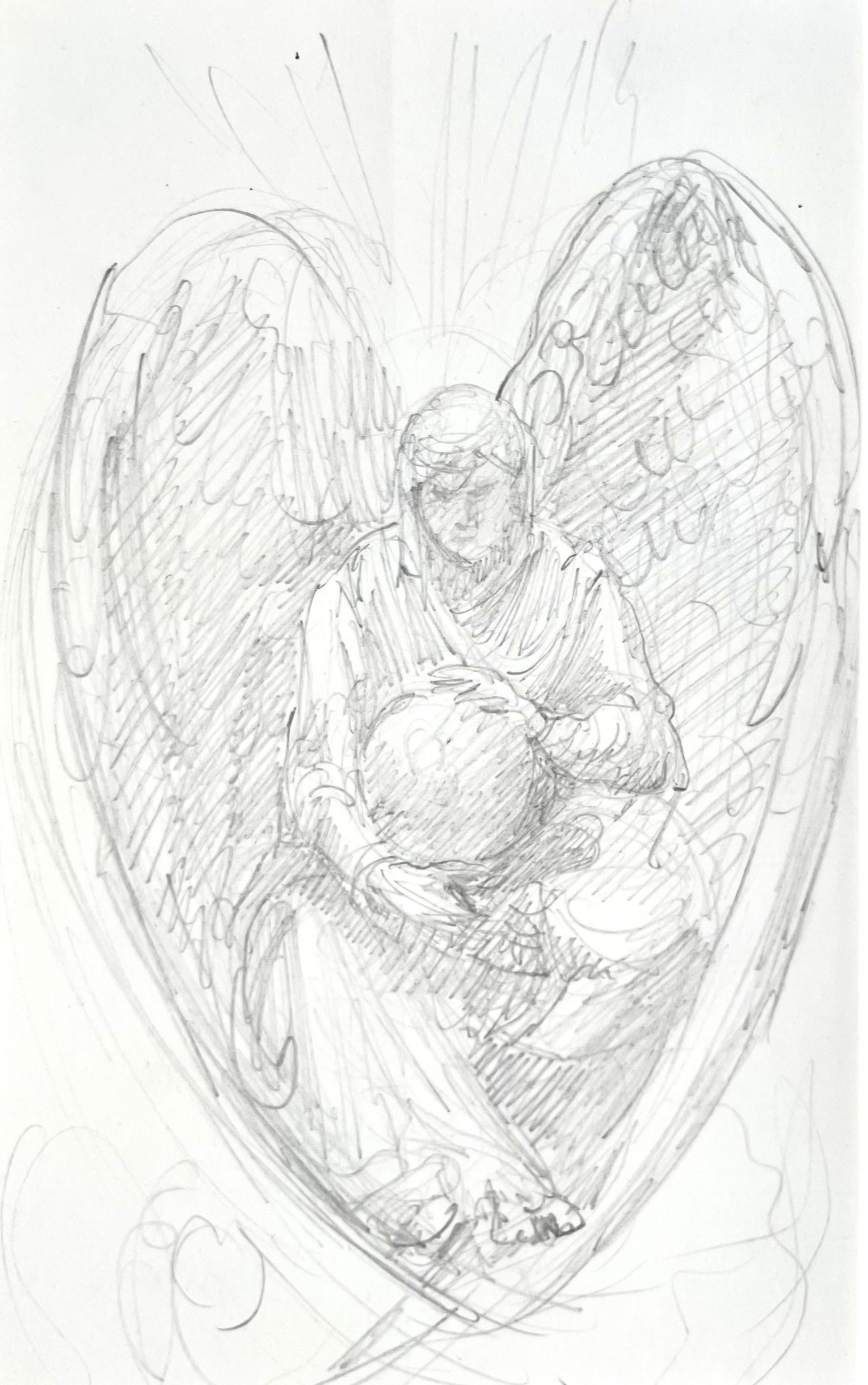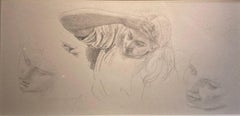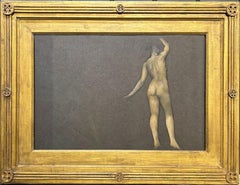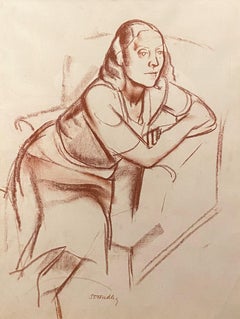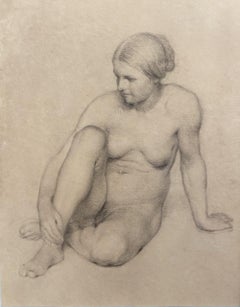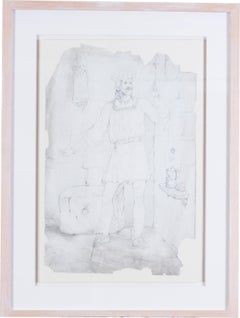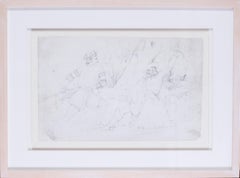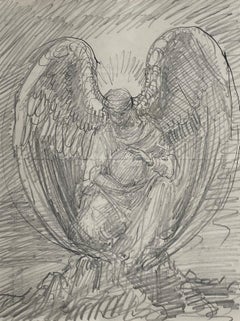Items Similar to Study for Last Sleep of Arthur in Avalon
Want more images or videos?
Request additional images or videos from the seller
1 of 3
Sir Edward Burne-JonesStudy for Last Sleep of Arthur in Avalon
$9,822.12
£7,200
€8,462.20
CA$13,755.54
A$15,122.65
CHF 7,817.13
MX$180,952.13
NOK 98,689.52
SEK 92,524.19
DKK 63,200.44
About the Item
Graphite on paper
Image size: 7 1/2 x 9 inches (19 x 23 cm)
Carved gilt frame
Literature
Illustrated in Malcolm Bell's 'Sir Edward Burne-Jones, A Record and Review', London, 1899, p.127.
Provenance
Major Charles Sydney Goldman 1958
By descent to his Sons
John and Margaret Monck (John Goldman Monck) 1958-1963
Commander Victor Robert Penryn Monck (Victor Robert Penryn Monk Goldman) 1958-1963
Christie's London (Christie, Manson and Woods) 1963, John Monck and Cmdr Penryn Monck sale 26 April 1963 part lot 71
Sir John Richardson, 2019
Burne-Jones decided that the folds in the drapery in this study were too complex for the final painting and fairly soon after he simplified the draperies.
The work is a drapery study for the seated figures at the centre of Sir Edward Coley Burne-Jones monumental The Sleep of Arthur in Avalon (Museo de Arte de Ponce, Puerto Rico). The artist spent seventeen years working on the complex narrative, even moving his studio to a larger space to accommodate the canvas. Born as a commission from his patron George Howard, 9th Earl of Carlisle, to decorate a wall in his library at Naworth Castle, The Sleep of Arthur in Avalon was left unfinished in Burne-Jones’ studio upon his death. The work was bequeathed to a studio neighbour whose descendants sold it at auction in 1963, where it was purchased by Luis A. Ferré, politician and founder of the Museo de Arte de Ponce.
To his friends and family, Burne-Jones was known for his 'unpainted masterpieces'. Indeed, from his youth he made swift sketches, such as this study, that appeared effortless in contrast to his carefully crafted paintings and allowed him to work out ideas and refine details. He also drew outside of the studio, and his contemporaries remarked at his uncanny ability to do so while fully engaged in other activities. The painter W. Graham Robertson recalled; 'Once, while talking to me, he took up a little pocketbook and sketched absently as he carried on the conversation'.
The importance and role of these sketches to Burne-Jones were practical; to test out ideas and compositions directly from the mind and to use them for reference when he came to execute a final piece. Today, sketches such as this provide a useful insight to the artist's thought process as a primary source of evidence to expose gradual progression to final works.
As Burne-Jones’ work became increasing elaborate within his later compositions, so did the preparatory sketches, these exquisite and sensitive drawings were not just a compliment to the final piece, but works of art in themselves. From the 1870s onwards, Burne-Jones had an established method in the development towards a final painting. Beginning with rough exploratory sketches, he would gradually define his compositions through multiple individual sketches, isolating every detail within the scene and experimenting with various designs until he was completely satisfied with the final result.
- Creator:Sir Edward Burne-Jones (1833 - 1898, English)
- Dimensions:Height: 9 in (22.86 cm)Width: 7.5 in (19.05 cm)
- More Editions & Sizes:1 of 1Price: $9,822
- Medium:
- Movement & Style:
- Period:
- Condition:
- Gallery Location:London, GB
- Reference Number:1stDibs: LU52410529692
About the Seller
5.0
Vetted Professional Seller
Every seller passes strict standards for authenticity and reliability
Established in 2007
1stDibs seller since 2014
85 sales on 1stDibs
Typical response time: 2 hours
- ShippingRetrieving quote...Shipping from: London, United Kingdom
- Return Policy
Authenticity Guarantee
In the unlikely event there’s an issue with an item’s authenticity, contact us within 1 year for a full refund. DetailsMoney-Back Guarantee
If your item is not as described, is damaged in transit, or does not arrive, contact us within 7 days for a full refund. Details24-Hour Cancellation
You have a 24-hour grace period in which to reconsider your purchase, with no questions asked.Vetted Professional Sellers
Our world-class sellers must adhere to strict standards for service and quality, maintaining the integrity of our listings.Price-Match Guarantee
If you find that a seller listed the same item for a lower price elsewhere, we’ll match it.Trusted Global Delivery
Our best-in-class carrier network provides specialized shipping options worldwide, including custom delivery.More From This Seller
View AllPortrait Studies
By Edwin Longsden Long
Located in London, GB
Edwin Long
1829 - 1891
Portrait Studies
Graphite on paper
Image size: 4 x 8 inches (10 x 20.5 cm)
Framed
Edwin Longsden Long RA (1829-1891, British) wa...
Category
1850s Pre-Raphaelite Portrait Drawings and Watercolors
Materials
Graphite
Study of a Standing Female Nude
By Evelyn de Morgan
Located in London, GB
Evelyn de Morgan
Study of a Standing Female Nude
1855 - 1917
Black chalk and pastel on grey paper
Image size: 12 ½ x 19 inches (48.2 x 31.7 cm)
Pre-Raphaelite style frame
Provenance
J.S. Mass & Co., Ltd., London, J.X. Reynolds & Co., Ltd.
Once she had graduated from the Slade School of Art, Evelyn continued to draw every day for the rest of her life. Her drawings are enlightening not only for their skill and subject matter, but also for their ability to teach us her working process. From loose compositional sketches, Evelyn swiftly progressed to detailed life studies for the figures in her paintings. Choosing to draw mainly on a grey wove paper in pencil and pastel, Evelyn produced hundreds of figure studies. Her rigorously-examined double studies of clothed and nude figures are particularly fascinating and underline the artist’s obsession with the human form and her desire for accuracy. A deep understanding of anatomy is obvious in this drawing and looking at the work you feel as though you can reach out and feel the muscle and bone under the skin, that you could feel the pulse of life through the soft skin.
Evelyn de Morgan
Born into a landowning family, from an early age Evelyn De Morgan, née Pickering, demonstrated a precocious artistic talent and a passionate desire to pursue a career as an artist, writing in her diary on her seventeenth birthday ‘Art is eternal, life is short… I have not a moment to lose’ (Evelyn De Morgan’s Diary, 30 August 1872, De Morgan Foundation Archive). Her maternal uncle, the artist John Roddam Spencer-Stanhope encouraged her talents and accompanied her on her first formative journeys to Italy where she discovered the Renaissance masters, particularly Botticelli. Overcoming initial parental opposition, Evelyn enrolled at the newly formed Slade School in 1873, one of the first women to do so.
The Slade revolutionised women’s artistic education by allowing female students to study the nude from life alongside their male counterparts. Whilst at the Slade she began to submit work under her middle name Evelyn, rather than her Christian name Mary, as its gender ambiguity offered a chance for her work to be judged on its own merit.
One of her tutors, Edward Poynter...
Category
20th Century Victorian Nude Drawings and Watercolors
Materials
Pastel, Chalk, Paper
Woman at Rest, Signed Charcoal Sketch, 20th Century British
By James Stroudley
Located in London, GB
Charcoal on paper, signed lower left
Image size: 15 3/4 x 21 inches (40 x 53.5 cm)
Contemporary frame
James Stroudley
Stroudley was born in London on 17 June 1906, the son of James Stroudley, showcard and ticket writer. He studied at Clapham School of Art (1923-27) and then at the Royal College of Art (1927-30), where his teachers included Alan Gwynne-Jones and William Rothenstein. As a recipient of the first Abbey Scholarship he was able to spend three years in Italy from 1930, where he absorbed the influences of Giotto and Piero della Francesca, and produced one of the last wholly satisfying decorative cycles by a Rome Scholar of the period. From 1934, he exhibited at the Royal Society of British Artists, and was elected to its membership in the following year.
From the Second World War – in which he worked with the Camouflage Unit – Stroudley taught at St Martin’s School of Art and was a visiting lecturer at the Royal Academy Schools. Though he continued to live in London, his later work, exhibited at the Royal Academy from 1955, indicated regular painting trips to Kent and Sussex coasts. However, much of his later work was abstract. In 1971, his former student, Peter Coker, paid homage to Stroudley by including his work in the exhibition ‘Pupil & Masters’, held at Westgate House, Long Melford, Suffolk.
Stroudley married three times, and his wives included the fashion artist to the Sun newspaper...
Category
Mid-20th Century Modern Figurative Drawings and Watercolors
Materials
Paper, Charcoal
Study of a Woman Sitting, Graphite Drawing, 19th Century French School
Located in London, GB
Graphite on paper
Image size: 13 x 10 1/2 inches (33 x 27 cm)
Mounted
This is a delicate 19th century academic graphite drawing of a seated female nude in the neoclassical style.
A...
Category
19th Century French School Nude Drawings and Watercolors
Materials
Paper, Graphite
Death the Bride, Late 19th Century Pre-Raphaelite Graphite on Paper
By Thomas Cooper Gotch
Located in London, GB
Thomas Cooper Gotch RBA RI
1854 - 1931
Death the Bride
Graphite on paper
Image size: 44 x 34 inches
Pre Raphaelite Style frame
The title of the painting comes from Shakespeare. It ...
Category
Late 19th Century Pre-Raphaelite Figurative Drawings and Watercolors
Materials
Graphite
A Study of Thomas Cooper Gotch, 19th Century Graphite Sketch
Located in London, GB
Graphite on paper
Image size: 5 1/2 x 20 1/2 inches (14 x 52 cm)
Framed
This sketch is a portrait of Thomas Gotch is by his lifelong friend and confidante, Jane Ross, whom he met at...
Category
Mid-19th Century English School Portrait Drawings and Watercolors
Materials
Graphite
You May Also Like
Beauty - Original lithograph - 1897
By Edward Burne-Jones
Located in Paris, IDF
Edward Burne-Jones
Beauty, 1898
Original lithograph (Champenois workshop)
Printed signature in the plate
On vellum, 40 x 31 cm (c. 16 x 12 in)
INFORMATION: Lithograph created for t...
Category
1890s Art Nouveau Portrait Prints
Materials
Lithograph
Pre-Raphaelite, early 19th Century drawing by the British artist Lord Leighton
By Frederic Leighton
Located in Petworth, West Sussex
Lord Frederick Leighton (British, 1830-1896)
A Medieval Allegory
Not signed
pencil on paper
the fragment measures approx. 19.1/2 x 13 in.
(49.5 x 33 cm.)
Provenance: Gifted by Leighton to his cousin Edith Emily Jellicorse, nee Garnham, and thence by descent.
We would like to thank Daniel Robins, the curator at Leighton House for the authenticating this work in full.
Daniel has suggested this study would have been executed when Leighton was studying in Frankfurt
Leighton was born in Scarborough to Augusta Susan and Dr. Frederic Septimus Leighton. He received his artistic training on the European continent, first from Eduard von Steinle and then from Giovanni Costa. According to Daniel Robbins, the curator at Leighton House, This drawing comes from the time Leighton studied under Eduard von Steinle. He then studied at the Accademia di Belle Arti in Florence. From 1855 to 1859 he lived in Paris, where he met Ingres, Delacroix, Corot and Millet. In 1860, he moved to London, where he associated with the Pre-Raphaelites. In 1864 he became an associate of the Royal Academy and in 1878 he became its President (1878–96). American art critic Earl Shinn claimed at the time that "Except Leighton, there is scarce any one capable of putting up a correct frescoed figure in the archway of the Kensington Museum." His paintings represented Britain at the great 1900 Paris Exhibition. Leighton was knighted at Windsor in 1878 and was created a baronet, of Holland Park Road eight years later. He was the first painter to be given a peerage. Leighton remained a bachelor and rumours of him having an illegitimate child with one of his models, in addition to the supposition that Leighton may have been a homosexual, continue to be debated. On his death his barony was extinguished after existing for only a day; this is a record in the Peerage. His house in Holland Park, London has been turned into a museum. It contains many of his drawings and paintings, as well as some of his former art collection including a painting dedicated to Leighton by Sir John Everett Millais. The house also features many of Leighton's inspirations, including his collection of Iznik tiles. Its centrepiece is the magnificent Arab Hall. Leighton was an enthusiastic volunteer soldier, enrolling with the first group to join the 38th Middlesex (Artists') Rifle Volunteer Corps (later to be known as the Artists Rifles...
Category
19th Century Pre-Raphaelite Figurative Drawings and Watercolors
Materials
Paper, Pencil
Lord Frederick Leighton drawing, British pre-Raphaelite, original
By Frederic Leighton
Located in Petworth, West Sussex
Lord Frederick Leighton (British, 1830-1896)
Apprehending a thief
pencil on paper
the fragment measures approx. 17.1/3 x 11in. (44 x 28cm.)
signed ‘F Leighton’ (lower right)
Provenance: Gifted by Leighton to his cousin Edith Emily Jellicorse, nee Garnham, and thence by descent
We would like to thank Daniel Robins, the curator at Leighton House for the authenticating this work in full.
Daniel has suggested this study would have been executed when Leighton was studying in Frankfurt
Leighton was born in Scarborough to Augusta Susan and Dr. Frederic Septimus Leighton. He received his artistic training on the European continent, first from Eduard von Steinle and then from Giovanni Costa. According to Daniel Robbins, the curator at Leighton House, This drawing comes from the time Leighton studied under Eduard von Steinle. He then studied at the Accademia di Belle Arti in Florence. From 1855 to 1859 he lived in Paris, where he met Ingres, Delacroix, Corot and Millet. In 1860, he moved to London, where he associated with the Pre-Raphaelites. In 1864 he became an associate of the Royal Academy and in 1878 he became its President (1878–96). American art critic Earl Shinn claimed at the time that "Except Leighton, there is scarce any one capable of putting up a correct frescoed figure in the archway of the Kensington Museum." His paintings represented Britain at the great 1900 Paris Exhibition. Leighton was knighted at Windsor in 1878 and was created a baronet, of Holland Park Road eight years later. He was the first painter to be given a peerage. Leighton remained a bachelor and rumours of him having an illegitimate child with one of his models, in addition to the supposition that Leighton may have been a homosexual, continue to be debated. On his death his barony was extinguished after existing for only a day; this is a record in the Peerage. His house in Holland Park, London has been turned into a museum. It contains many of his drawings and paintings, as well as some of his former art collection including a painting dedicated to Leighton by Sir John Everett Millais. The house also features many of Leighton's inspirations, including his collection of Iznik tiles. Its centrepiece is the magnificent Arab Hall. Leighton was an enthusiastic volunteer soldier, enrolling with the first group to join the 38th Middlesex (Artists') Rifle Volunteer Corps (later to be known as the Artists Rifles...
Category
19th Century Pre-Raphaelite Figurative Drawings and Watercolors
Materials
Paper, Pencil
Study of an Angel by British Pre-Raphaelite artist Sir William Blake Richmond
By Sir William Blake Richmond
Located in London, GB
SIR WILLIAM BLAKE RICHMOND, RA
(1842-1921)
Study of an Angel
Pencil on the artist’s writing paper for Beavor Lodge, Hammersmith
Unframed
22.5 by 17 cm., 9 by 6 ¾ in.
(mount size ...
Category
1890s Pre-Raphaelite Figurative Drawings and Watercolors
Materials
Pencil
An early 19th Century drawing by the British pre-Raphaelite artist Lord Leighton
By Frederic Leighton
Located in Petworth, West Sussex
Lord Frederick Leighton (British, 1830-1896)
A very early study of a Medieval Minstrel
pencil on paper
Not signed
the fragment measures approx. 19.1/2 x 13 in.
(49.5 x 33 cm.)
Provenance: Gifted by Leighton to his cousin Edith Emily Jellicorse, nee Garnham, and thence by descent.
We would like to thank Daniel Robins, the curator at Leighton House for the authenticating this work in full.
Daniel has suggested this study would have been executed when Leighton was studying in Frankfurt
Leighton was born in Scarborough to Augusta Susan and Dr. Frederic Septimus Leighton. He received his artistic training on the European continent, first from Eduard von Steinle and then from Giovanni Costa. According to Daniel Robbins, the curator at Leighton House, This drawing comes from the time Leighton studied under Eduard von Steinle. He then studied at the Accademia di Belle Arti in Florence. From 1855 to 1859 he lived in Paris, where he met Ingres, Delacroix, Corot and Millet.
In 1860, he moved to London, where he associated with the Pre-Raphaelites. In 1864 he became an associate of the Royal Academy and in 1878 he became its President (1878–96). American art critic Earl Shinn claimed at the time that "Except Leighton, there is scarce any one capable of putting up a correct frescoed figure in the archway of the Kensington Museum." His paintings represented Britain at the great 1900 Paris Exhibition.
Leighton was knighted at Windsor in 1878 and was created a baronet, of Holland Park Road eight years later. He was the first painter to be given a peerage.
Leighton remained a bachelor and rumours of him having an illegitimate child with one of his models, in addition to the supposition that Leighton may have been a homosexual, continue to be debated. On his death his barony was extinguished after existing for only a day; this is a record in the Peerage. His house in Holland Park, London has been turned into a museum. It contains many of his drawings and paintings, as well as some of his former art collection including a painting dedicated to Leighton by Sir John Everett Millais. The house also features many of Leighton's inspirations, including his collection of Iznik tiles. Its centrepiece is the magnificent Arab Hall.
Leighton was an enthusiastic volunteer soldier, enrolling with the first group to join the 38th Middlesex (Artists') Rifle Volunteer Corps (later to be known as the Artists Rifles...
Category
19th Century Pre-Raphaelite Figurative Drawings and Watercolors
Materials
Paper, Pencil
Sir William Blake Richmond - An Angel - 19th Century British Drawing
By Sir William Blake Richmond
Located in London, GB
SIR WILLIAM BLAKE RICHMOND, RA
(1842-1921)
Study of an Angel
Pencil
Unframed, in mount only
18.5 by 10.5 cm., 7 ¼ by 4 ¼ in.
(mount size 32 by 25 cm., 12 ½ by 10 in.)
William Bl...
Category
Late 19th Century Pre-Raphaelite Figurative Drawings and Watercolors
Materials
Pencil
More Ways To Browse
George Earl
Robert Wood Paintings For Sale
Antique Puerto Rico
Male Figure Drawing
Pastel Drawing Woman
Nude Male Model
Art Deco Pencil Drawings
Fashion Drawing Original
Watercolors Faces
19th Century Pen And Ink Drawings
Western Drawings
Watercolour Caricatures
Old Master Drawings Framed
Mid Century Charcoal Portrait
Mid Century Drawings Figure
Charcoal Drawing Portraits Early 20th Century
Chinese Pencil
Antique Drawing Board
